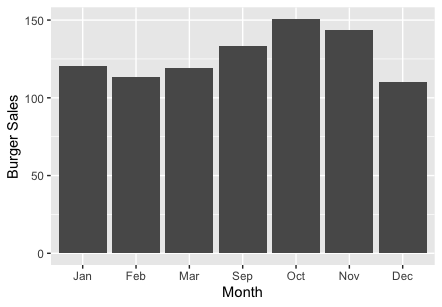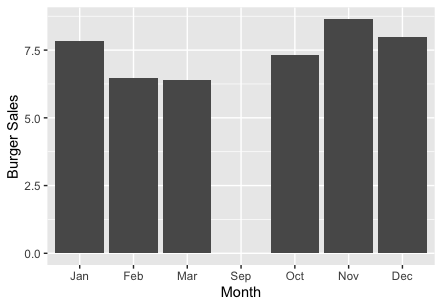In 2022, University of Victoria, in British Columbia committed to a Climate and Sustainability Action Plan, set to be achieved by 2030, inspiring others to lead the way globally in environmental, social and institutional sustainability.
This research proposal asks the question: Can the promotion of sustainable food choices during targeted global climate action events significantly alter conventional meat consumption in Canadian universities?
The proposal provides benefits to students, staff, community members and local vendors along with Food Services on campus through promoting alternatives and optimized climate action messaging.
Erica Christie, Manager of University Food Services, acknowledged the current beef burger on campus is “50% pea protein, the university moved to this product in September 2022 in an effort to reduce beef consumption on campus” (March 15, 2023).
Descriptive Statistics
A review of the past annual product quantity consumption of beef burgers on campus over the past 12 months, provided by Food Services, revealed the month of October as recording the highest mean daily product quantity consumption for Cove. Staffing changes limited Flamin’ Good Grill’s operations between Sept 2022- March 2023.
In order to isolate the data two separate .xls documents were created for the data, one for each restaurant 1- Cove 2- Flamin’ Good Grill. The data is available for download below:
Cove
Table 1. Mean Scores and Standard Deviations of Product Quantity Means per Month Cove
| Sept 2022 | Oct 2022 | Nov 2022 | Dec 2022 | |
| Mean | 133.34 | 150.68 | 143.67 | 110.47 |
| Std. Dev. | 68.64 | 76.33 | 67.45 | 52.73 |
Figure 1- Beef Burger Consumption Monthly Mean Cove Sept 2022-March 2023


Figure 2- 175 values of Cove Beef Consumption Sept 2022-March 2023
Flamin’ Good Grill
Table 2. Mean Scores and Standard Deviations of Product Quantity Means per Month Flamin’ Good Grill
| Sept 2022 | Oct 2022 | Nov 2022 | Dec 2022 | |
| Mean | NULL | 7.33 | 8.65 | 8 |
| Std. Dev. | NULL | 2.41 | 2.8 | 1.41 |
Figure 3- Beef Burger Consumption Monthly Mean Flamin’ Good Grill Sept 2022-March 2023

Figure 4- 75 values of Flamin’ Good Grill Beef Consumption Sept 2022-March 2023

The primary article reviewed for this research question was Larner et al. (2021) whose study on climate strike intervention provided evidence of decreases in sales for beef burgers, compared to increases in sales for chicken and meat-free burgers. Larner et al. (2021) illustrates an industry example of a consumer experiment supervised on-site in university student union buildings related to the meat-climate issue. Larner et al. (2021) study, provided evidence of a decrease in beef burger sales on the day of the Climate Strike Intervention and increases in chicken and meat-free burger sales on campus.
According to FAO (2015) emissions reduction from the livestock sector can be achieved by reducing production and consumption. Larner et al. (2021) and others postulate a “rapid dietary shift away from animal products, especially beef, lamb and dairy products is necessary to reduce diet-related GHGE and avoid further climate warming” (Camilleri et al., 2019, Rust et al., 2020, Reynolds et al., 2014 as cited in Larner et al., 2021, p. 2). The significance of Larner et al. (2021) study led to MacMillan and Dooley’s (2023) current two-year project at the Royal Agricultural University in the United Kingdom to explore what, if any, concerns farmers may have about the impact of agricultural changes for climate change related to cultured meat.
Materials
Product quantity consumption data was collected by Food Services for daily means of beef product quantity for the twelve months preceding the study which consisted of an excel spreadsheet containing 250 data entries over seven months (Sept, Oct, Nov, Dec, Jan, Feb, Mar) prior on campus for comparison and data analysis. There are two UVic Food Services run establishments included in the data collection: Cove and Flamin’ Good Grill. An R Script was used to complete statistical analysis of the comma separated value data provided from Food Services.
The non-directional null hypothesis posits that the October 2023 daily mean consumption will not differ significantly (p > .05) from the reported October 2022 daily mean consumption of 150.68 (SD 76.33 ). The alternative hypothesis posits that the October 2023 daily mean consumption will be significantly different (p < .05) from the reported October 2022 daily mean consumption of 150.68 (SD 76.33 ).
Data collected by Food Services at the University of Victoria was used as a framework to identify the Independent Variable (IV) factors as the months: September, October, November, December, January, February, March and Dependent Variable (DV) to be sum of burger sales averaged mean each month.
With all these factors presented on product quantity and timing of climate action, this research proposal aims to determine if a difference in the means of product quantity of beef is a function of the timing of climate action.
This result will then be compared to other campuses across Canada, such as the sustainability food website featured on University of Lethbridge website UoL Sustainability Food
Appendices
To view output from an R script, R studio is required to be installed. https://www.rstudio.com/tags/rstudio-ide/
R studio can be installed on any desktop or laptop and one of these two devices is a required material to view the data and replicate the study.
References
Babin, B.J., Harris, E., & Murray, K.B. (2017). Consumer Behaviour (2nd Canadian Ed.) Toronto, ON. Cengage Learning Inc.
Bacon, L., & Krpan, D. (2018). (Not) Eating for the environment: The impact of restaurant menu design on vegetarian food choice. Appetite, 125, 190-200.
Cai, C. H., Ding, A., & Legendre, T. S. (2021). Exploring persuasive sales techniques to improve customer acceptance of sustainable but unfamiliar menu in restaurants. International Journal of Contemporary Hospitality Management.
Camilleri, A. R., Larrick, R. P., Hossain, S., & Patino-Echeverri, D. (2019). Consumers underestimate the emissions associated with food but are aided by labels. Nature Climate Change, 9(1), 53-58.
Canada’s Top 100 (n.d.). Retrieved April 4, 2023, from
https://reviews.canadastop100.com/top-employer-university-of-victoria.
Castellari, E., Marette, S., Moro, D., & Sckokai, P. (2018). Can menu labeling affect away-from-home-dietary choices?. Bio-Based and Applied Economics, 7(3), 249-263.
Christie, E. (2023). Emailed communication
Climate & Sustainability Action Plan 2030 – university of victoria – university of victoria. UVic.ca. (n.d.). Retrieved March 25, 2023, from https://www.uvic.ca/about-uvic/climate-sustainability-plan/index.php
Davis, C., & MacKenize, S. (2013). That’s All Folks…. Public, 24(48), 12-18. Exploring Consumption Forced Choice During Climate Action Events on Campus 13
De Boer, J., Schösler, H., & Boersema, J. J. (2013). Climate change and meat eating: An inconvenient couple?. Journal of Environmental Psychology, 33, 1-8.
Druckman, J. N. (2001). The implications of framing effects for citizen competence. Political behavior, 23(3), 225-256.
Fao.org. Dashboard-old | Global Livestock Environmental Assessment Model (GLEAM) | Food and Agriculture Organization of the United Nations. (n.d.). Retrieved January 15, 2023, from https://www.fao.org/gleam/dashboard-old/en/
Foodandagricultureorganization.shinyapps.io. (n.d.). Retrieved January 15, 2023, from https://foodandagricultureorganization.shinyapps.io/GLEAMV3_Public/
Eustachio Colombo, P., Patterson, E., Lindroos, A. K., Parlesak, A., & Elinder, L. S. (2020). Sustainable and acceptable school meals through optimization analysis: an intervention study. Nutrition journal, 19(1), 1-15.
Gifford, R. (2011). The dragons of inaction: psychological barriers that limit climate change mitigation and adaptation. American psychologist, 66(4), 290.
Gifford, K., & Bernard, J. C. (2006). Influencing consumer purchase likelihood of organic food. International Journal of Consumer Studies, 30(2), 155-163.
Gifford, R., & Comeau, L. A. (2011). Message framing influences perceived climate change competence, engagement, and behavioral intentions. Global Environmental Change, 21(4), 1301-1307. Exploring Consumption Forced Choice During Climate Action Events on Campus 14
Grundy, J., & Boudreau, J. A. (2008). ‘Living with culture’: creative citizenship practices in Toronto. Citizenship Studies, 12(4), 347-363
Heesterman, T. (2023). Emailed Communication.
Ji, L. J., Lappas, C. M., Wang, X. Q., & Meier, B. P. (2022). The Naturalness Bias Influences Drug and Vaccine Decisions across Cultures. Medical Decision Making, 0272989X221140803.
Kaljonen, M., Salo, M., Lyytimäki, J., & Furman, E. (2020). From isolated labels and nudges to sustained tinkering: assessing long-term changes in sustainable eating at a lunch restaurant. British Food Journal.
Larner, E., Fish, A. L., Way, C. H., Graham, F., Armstrong, B., Patel, V., … & Reynolds, C. J. (2021). Reaction to a low-carbon footprint food logo and other sustainable diet promotions in a UK University’s Student Union ‘Living Lab’.
Lee, K., & Ashton, M. C. (2012). The H Factor of Personality. Waterloo, ON: Wilfrid Laurier University Press.
Mah, E., McCreary, B., & Yoneda, T. (2021). Undergraduate Diversity Survey. University of Victoria. Retrieved April 4, 2023, from https://www.uvic.ca/socialsciences/psychology/assets/docs/udergraduate/edi-report-2021-09.25v7.pdf
MacMillan, T. and Dooley, J (2023). Zoom Interview, Feb 28, 2023. Exploring Consumption Forced Choice During Climate Action Events on Campus 15
Miliokas, L. C. (2017). Through” the forest of things, acts, and signs”: A study of Edmonton’s The Works Art and Design Festival and Nuit Blanche (Doctoral dissertation, The University of Regina (Canada)).
Miliokas, L. (2018). Under “The Half-Lit Moon”: Theories of Expanded Cinema and Nuit Blanche Edmonton 2015. Canadian Journal of Film Studies, 27(1), 31-43.
Reckitt, H. (2013). Because the Night: Curating One-Off Nocturnal Events. Art Papers, 37(3), 42-45.
Reynolds, C. J., Buckley, J. D., Weinstein, P., & Boland, J. (2014). Are the dietary guidelines for meat, fat, fruit and vegetable consumption appropriate for environmental sustainability? A review of the literature. Nutrients, 6(6), 2251-2265.
Rosenfeld, D. L., & Tomiyama, A. J. (2022). Would you eat a burger made in a petri dish? Why people feel disgusted by cultured meat. Journal of Environmental Psychology, 80, 101758.
Rozin, P., Spranca, M., Krieger, Z., Neuhaus, R., Surillo, D., Swerdlin, A., & Wood, K. (2004). Preference for natural: instrumental and ideational/moral motivations, and the contrast between foods and medicines. Appetite, 43(2), 147-154.
Rust, N. A., Ridding, L., Ward, C., Clark, B., Kehoe, L., Dora, M., … & West, N. (2020). How to transition to reduced-meat diets that benefit people and the planet. Science of the Total Environment, 718, 137208.
Ruzgys, S., & Pickering, G. J. (2020). Perceptions of cultured meat among youth and messaging strategies. Frontiers in Sustainable Food Systems, 4, 122. Exploring Consumption Forced Choice During Climate Action Events on Campus 16
Scannell, L., & Gifford, R. (2013). Personally relevant climate change: The role of place attachment and local versus global message framing in engagement. Environment and Behavior, 45(1), 60-85.
Sisson, E. D. (1948). Forced choice—The new army rating 1. Personnel Psychology, 1(3), 365-381.
Stea, S., & Pickering, G. J. (2019). Optimizing messaging to reduce red meat consumption. Environmental Communication, 13(5), 633-648.
Travers, R. M. (1951). A critical review of the validity and rationale of the forced-choice technique. Psychological Bulletin, 48(1), 62.
University of Victoria. (2002). Retrieved April 4, 2023, from https://www.uvic.ca/institutionalplanning/assets/docs/applicants/apps_fall2002.
